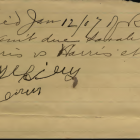Notes on the State of Virginia: Journey to the Center of an American Document, Queries XV-XVI

This is the eighth installment of a year-long journey through Thomas Jefferson’s Notes on the State of Virginia.
**
Query XV: The colleges and public establishments, the roads, buildings, &c.
Query XVI: The measures taken with regard to the estates and possessions of the rebels, commonly called Tories
In these two queries, Jefferson continues his extended description of Virginian civilization. While previous sections have detailed some of the ideological and demographic categories to which the Commonwealth’s inhabitants may belong—slaves, Indians, farmers, artisans, citizen-soldiers—this portion of Notes focuses on the material goods and physical spaces created by and for the public. Jefferson is preoccupied with fostering permanent architecture in the new nation, and he critiques, in stinging terms, the current state of Virginia’s built landscape:
The [College of William and Mary] and hospital are rude, misshapen piles, which, but that they have roofs, would be taken for brick-kilns. There are no other public buildings but churches and court-houses, in which no attempts are made at elegance. (…) The genius of architecture seems to have shed its maledictions over this land.
Much to his frustration, Jefferson’s Virginia is a continually shifting assemblage of wooden churches, humble cottages of stacked logs, and just a few public buildings “of well-burnt brick and good mortar.” The preponderance of timber construction, and the relative impermanence of such edifices, are especially bothersome for a self-taught, neoclassical builder like Jefferson, who prefers the “symmetry and taste” of brick or stone. In fact, he spends much of Query XV praising the virtues of brick over wood, with the central portion of his argument focused on the notion of fixity:
A country whose buildings are of wood, can never increase in its improvements to any considerable degree. Their duration is highly estimated at fifty years. Every half century then our country becomes a tabula rasa, whereon we have to set out anew, as in the first moment of seating it. Whereas when buildings are of durable materials, every new edifice is an actual and permanent acquisition to the State, adding to its value as well as to its ornament.
To my poet’s mind, paragraphs like these raise fascinating questions about the materiality of language. In a poem, words are supposed to be the bricks, the mortar and the wood. But they’re also the freezing drafts, the burst pipes, and the light that glows from a dwindling lamp. So what, in poetry, might count as “durable material?” Is the “tabula rasa” of the blank page a fearful thing, or a celebratory circumstance when it comes to the creative process? In my own writing life, I find myself powerfully drawn to language that acknowledges the porousness of meaning. I love the subtle slippage that occurs when a noun at the end of an enjambed line morphs into an adjective when re-contextualized by the line that follows it.
At the same time, I have to recognize that poetic form itself makes those discursive acrobatics possible. Poetic structure is more than any single “recipe” for a kind of poem. A sonnet is a sonnet not because it follows the “rules,” but because it works with and against our expectations of that form. Poetic form is just a set of expectations, which the poet may fulfill or resist in complex ways. And though the poem always appears on the page before us as a seemingly complete item of language, the most exciting lyric utterances are those which are full of silences and strange gaps, or alive with the ghosts of previous poems, or desperately trying to connect with an absent other. Take these opening lines from Frank O’Hara’s “To the Harbormaster,” from his 1957 book, Meditations in an Emergency:
I wanted to be sure to reach you;
though my ship was on the way it got caught
in some moorings. I am always tying up
and then deciding to depart.
This is one of my favorite poems in the whole world because of the beautiful way it addresses its own uncertainty. As readers, we don’t know who the “harbormaster” may be, but this addressee seems, initially, to symbolize a kind of authoritative fixity the speaker craves. O’Hara’s speaker “want[s] to be sure,” but gets “caught” in the very “moorings” that once promised safety and stability. Something’s wrong with the sequence of the speaker’s actions here; he ties up his ship and then decides to take off. This seeming belatedness puts him at odds with the rest of the world—the world of chronology, symmetry, and causal narrative, to name just some of Jefferson’s favorite concepts.
But just as the poem disrupts our sense of fixity, it also works to establish the poet-self as a potential site of authority. The word “sure” reaches our ears and fragments into at least two meanings: “sure” and “shore,” two meanings contained within the same sound. This sonic doubling suggests a connection between the surety of the “I” and the “shore” he’s trying to reach. Perhaps the speaker takes some of the shore with him, no matter where he sails. Perhaps the poem itself makes a kind of shoreline, a place for poet and reader to meet and “get caught” in the purposeful aesthetic and intellectual exchange that is the reading experience. In this light, O’Hara’s subsequent choice of the word “always” becomes vital. If the speaker knows that he “always” does something, then that suggests a pattern of action, a kind of self-knowledge that brings stability to the poem. O’Hara’s speaker is the sort of person who ties up before setting forth. Other speakers may do it another way. But this speaker “always” addresses the world like this. Somehow we can trust this speaker’s always-ness. We can get into the boat and travel with him, not only for the duration of this poem, but for the whole book.
The more I think about Jefferson’s preferences for “durable” building materials, the more attached to wood I become. Wood is porous, organic, a living system. It bends. It allows particles—of water, of light—to travel within. I want to write poems with the strength and mortality of wood, poems that are capacious enough for my optimism and my uncertainty. A poem of wood is an energetic poem, similar in some ways to the dynamism Jefferson observes in Virginia’s eighteenth-century landscape. Through these spaces moves the invisible but potent energy of the nascent state, which, as Jefferson explains in Query XVI, has rendered “forfeit” and “irrecoverable” the majority of Tory lands and property. But though these places are “lost” to the Tories, they still occupy the same points on Virginia’s map. Every element of the colonial world—its roads and estates, its systems of taxation, even the structure of its universities—is now transitioning into a post-revolution, distinctly American body.
It’s a marvelous and perilous change. And it’s still happening.



